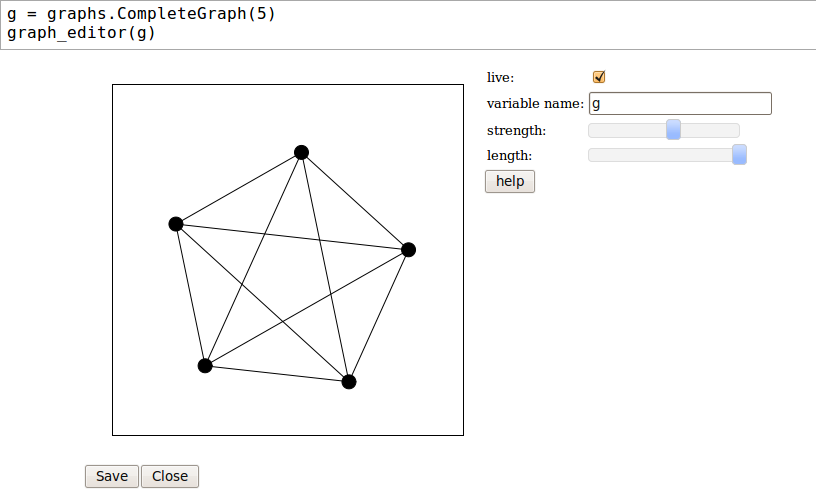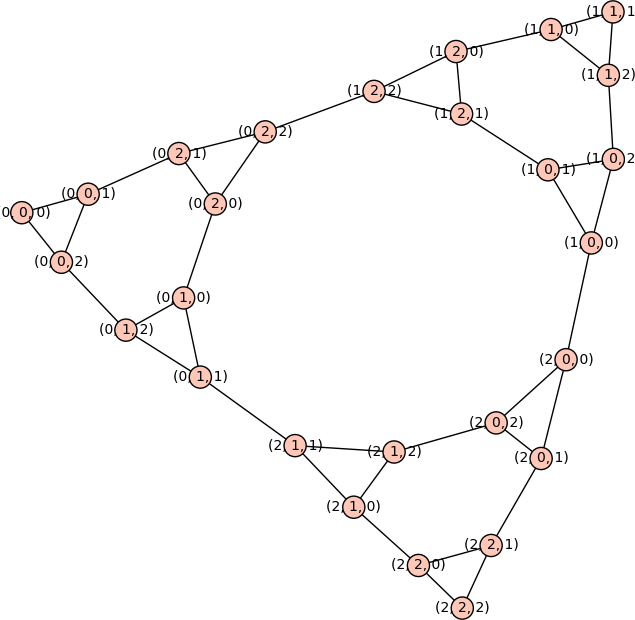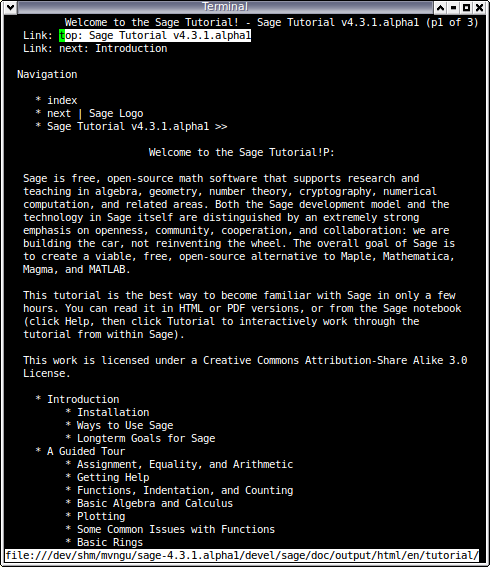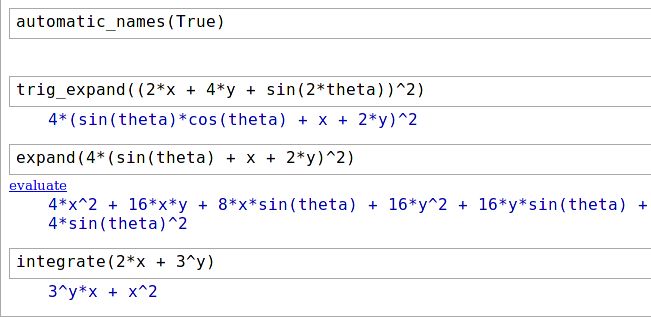|
Size: 26809
Comment:
|
Size: 26906
Comment:
|
| Deletions are marked like this. | Additions are marked like this. |
| Line 465: | Line 465: |
| * [[http://trac.sagemath.org/sage_trac/ticket/7703 | #7703]] | * S-units, S-class groups, and selmer groups of etale algebras (and number fields) [[http://trac.sagemath.org/sage_trac/ticket/7703 | #7703]] (Robert Miller) |
| Line 494: | Line 494: |
| * Small change to elcib build script (eclib ignores SAGE64 if OS is not Darwin) [[http://trac.sagemath.org/sage_trac/ticket/7814 | #7814]] | * Small change to eclib build script (eclib ignores SAGE64 if OS is not Darwin) [[http://trac.sagemath.org/sage_trac/ticket/7814 | #7814]] |
Sage 4.3.1 Release Tour
Contents
Major features
Substantial work towards a complete SPARC Solaris 10 port. This is due to the hard work of David Kirkby. The relevant tickets include #6595, #7067, #7138, #7162, #7387, #7505, #7781, #7815, #7817, #7849
We're moving closer towards a FreeBSD port, thanks to the work of Peter Jeremy at ticket #7825.
Algebra
Chinese Remainder Theorem for polynomials #7595 (Robert Miller) -- An implementation of the Chinese Remainder Theorem is needed for general descents on elliptic curves. Here are some examples for polynomial rings:
sage: K.<a> = NumberField(x^3 - 7) sage: R.<y> = K[] sage: f = y^2 + 3 sage: g = y^3 - 5 sage: CRT(1,3,f,g) -3/26*y^4 + 5/26*y^3 + 15/26*y + 53/26 sage: CRT(1,a,f,g) (-3/52*a + 3/52)*y^4 + (5/52*a - 5/52)*y^3 + (15/52*a - 15/52)*y + 27/52*a + 25/52
This also works for any number of moduli:sage: K.<a> = NumberField(x^3 - 7) sage: R.<x> = K[] sage: CRT([], []) 0 sage: CRT([a], [x]) a sage: f = x^2 + 3 sage: g = x^3 - 5 sage: h = x^5 + x^2 - 9 sage: k = CRT([1, a, 3], [f, g, h]); k (127/26988*a - 5807/386828)*x^9 + (45/8996*a - 33677/1160484)*x^8 + (2/173*a - 6/173)*x^7 + (133/6747*a - 5373/96707)*x^6 + (-6/2249*a + 18584/290121)*x^5 + (-277/8996*a + 38847/386828)*x^4 + (-135/4498*a + 42673/193414)*x^3 + (-1005/8996*a + 470245/1160484)*x^2 + (-1215/8996*a + 141165/386828)*x + 621/8996*a + 836445/386828 sage: k.mod(f) 1 sage: k.mod(g) a sage: k.mod(h) 3
Basic arithmetics
Implement conjugate() for RealDoubleElement #7834 (Dag Sverre Seljebotn) --- New method conjugate() in the class RealDoubleElement of the module sage/rings/real_double.pyx for returning the complex conjugate of a real number. This is consistent with conjugate() methods in ZZ and RR. For example,
sage: ZZ(5).conjugate() 5 sage: RR(5).conjugate() 5.00000000000000 sage: RDF(5).conjugate() 5.0
Improvements to complex arithmetic-geometric mean #7739 (Robert Bradshaw) --- Adds an algorithm option to the method agm() for complex numbers. The values of algorithm be can:
- "pari" --- Call the agm function from the Pari library.
"optimal" --- Use the AGM sequence such that at each stage (a,b) is replaced by (a_1,b_1) = ((a+b)/2,\pm\sqrt{ab}) where the sign is chosen so that |a_1-b_1| \le |a_1+b_1|, or equivalently \Re(b_1/a_1)\ge0. The resulting limit is maximal among all possible values.
"principal" --- Use the AGM sequence such that at each stage (a,b) is replaced by (a_1,b_1) = ((a+b)/2,\pm\sqrt{ab}) where the sign is chosen so that \Re(b_1/a_1)\ge0 (the so-called principal branch of the square root).
sage: a = CDF(-0.95, -0.65) sage: b = CDF(0.683, 0.747) sage: a.agm(b, algorithm="optimal") -0.371591652352 + 0.319894660207*I sage: a.agm(b, algorithm="principal") 0.338175462986 - 0.0135326969565*I sage: a.agm(b, algorithm="pari") 0.080689185076 + 0.239036532686*I
New decorator coerce_binop #383 (Robert Bradshaw) --- The new decroator coerce_binop can be applied to methods to ensure the arguments have the same parent. For example
@coerce_binop def quo_rem(self, other): ...will guarantee that self and other have the same parent before this method is called.
Combinatorics
Weyl group optimizations #7754 (Nicolas M. Thiéry) --- Three major improvements that indirectly also improve efficiency of most Weyl group routines:
- Faster hash method calling the hash of the underlying matrix (which is set as immutable for that purpose).
New __eq__() method.
- Action on the weight lattice realization: optimization of the matrix multiplication.
BEFORE sage: W = WeylGroup(["F", 4]) sage: W.cardinality() 1152 sage: %time list(W); CPU times: user 10.51 s, sys: 0.05 s, total: 10.56 s Wall time: 10.56 s sage: W = WeylGroup(["E", 8]) sage: %time W.long_element(); CPU times: user 1.47 s, sys: 0.00 s, total: 1.47 s Wall time: 1.47 s AFTER sage: W = WeylGroup(["F", 4]) sage: W.cardinality() 1152 sage: %time list(W); CPU times: user 6.89 s, sys: 0.04 s, total: 6.93 s Wall time: 6.93 s sage: W = WeylGroup(["E", 8]) sage: %time W.long_element(); CPU times: user 1.21 s, sys: 0.00 s, total: 1.21 s Wall time: 1.21 s
Implement the Gale Ryser theorem #7301 (Nathann Cohen, David Joyner) --- The Gale Ryser theorem asserts that if p_1, p_2 are two partitions of n of respective lengths k_1, k_2, then there is a binary k_1 \times k_2 matrix M such that p_1 is the vector of row sums and p_2 is the vector of column sums of M, if and only if p_2 dominates p_1. T.S. Michael helped a great deal with the refereeing process. Here are some examples:
sage: from sage.combinat.integer_vector import gale_ryser_theorem sage: p1 = [4, 2, 2] sage: p2 = [3, 3, 1, 1] sage: gale_ryser_theorem(p1, p2) [1 1 1 1] [1 1 0 0] [1 1 0 0] sage: p1 = [4, 2, 2, 0] sage: p2 = [3, 3, 1, 1, 0, 0] sage: gale_ryser_theorem(p1, p2) [1 1 1 1 0 0] [1 1 0 0 0 0] [1 1 0 0 0 0] [0 0 0 0 0 0]
Iwahori Hecke algebras on the T basis #7729 (Daniel Bump, Nicolas M. Thiéry) --- Iwahori Hecke algebras are deformations of the group algebras of Coxeter groups, such as Weyl groups (finite or affine). Here are some examples:
sage: R.<q> = PolynomialRing(QQ) sage: H = IwahoriHeckeAlgebra("A3", q) sage: [T1, T2, T3] = H.algebra_generators() sage: T1 * (T2 + T3) * T1 T1*T2*T1 + (q-1)*T3*T1 + q*T3Coxeter groups: more Bruhat and weak order features #7753 (Nicolas M. Thiéry, Daniel Bump) --- Four new methods implementing the Bruhat order for Coxeter groups. The method bruhat_le() for Bruhat comparison:
sage: W = WeylGroup(["A", 3]) sage: u = W.from_reduced_word([1, 2, 1]) sage: v = W.from_reduced_word([1, 2, 3, 2, 1]) sage: u.bruhat_le(u) True sage: u.bruhat_le(v) True sage: v.bruhat_le(u) False sage: v.bruhat_le(v) True sage: s = W.simple_reflections() sage: s[1].bruhat_le(W.one()) False
The method weak_le() for comparison in weak order:
sage: W = WeylGroup(["A", 3]) sage: u = W.from_reduced_word([1, 2]) sage: v = W.from_reduced_word([1, 2, 3, 2]) sage: u.weak_le(u) True sage: u.weak_le(v) True sage: v.weak_le(u) False sage: v.weak_le(v) True
The method bruhat_poset() returns the Bruhat poset of a Weyl group:
sage: W = WeylGroup(["A", 3]) sage: P = W.bruhat_poset() sage: u = W.from_reduced_word([3, 1]) sage: v = W.from_reduced_word([3, 2, 1, 2, 3]) sage: P(u) <= P(v) True sage: len(P.interval(P(u), P(v))) 10 sage: P.is_join_semilattice() False
The method weak_poset() returns the left (resp. right) poset for weak order:
sage: W = WeylGroup(["A", 2]) sage: P = W.weak_poset(); P Finite poset containing 6 elements sage: W = WeylGroup(["B", 3]) sage: P = W.weak_poset(side="left") sage: P.is_join_semilattice(), P.is_meet_semilattice() (True, True)
Interval exchange transformations #7145 (Vincent Delecroix) --- New module for manipulating interval exchange transformations and linear involutions. Here, we create an interval exchange transformation:
sage: T = iet.IntervalExchangeTransformation(('a b','b a'),(sqrt(2),1)) sage: print T Interval exchange transformation of [0, sqrt(2) + 1[ with permutation a b b aIt can also be initialized using permutation (group theoretic ones):sage: p = Permutation([3,2,1]) sage: T = iet.IntervalExchangeTransformation(p, [1/3,2/3,1]) sage: print T Interval exchange transformation of [0, 2[ with permutation 1 2 3 3 2 1
For the manipulation of permutations of IET, there are special types provided by this module. All of them can be constructed using the constructor iet.Permutation. For the creation of labelled permutations of interval exchange +transformation:
sage: p1 = iet.Permutation('a b c', 'c b a') sage: print p1 a b c c b aAdd S-adic to the word generator #7543 (Sebastien Labbe) --- New method s_adic() returns the s-adic infinite word obtained from a sequence of morphisms applied on a letter. Here we define three morphisms and compute the first nested succesive prefixes of the s-adic word:
sage: m1 = WordMorphism('e->gh,f->hg') sage: m2 = WordMorphism('c->ef,d->e') sage: m3 = WordMorphism('a->cd,b->dc') sage: words.s_adic([m1],'e') word: gh sage: words.s_adic([m1,m2],'ec') word: ghhg sage: words.s_adic([m1,m2,m3],'eca') word: ghhgghWhen the given sequence of morphism is finite, one may simply give the last letter, i.e. "a", instead of giving all of them, i.e. "eca":sage: words.s_adic([m1,m2,m3],'a') word: ghhggh sage: words.s_adic([m1,m2,m3],'b') word: ghghhg
Elliptic curves
Two-isogeny descent over QQ natively using ratpoints #6583 (Robert Miller) --- New module sage/schemes/elliptic_curves/descent_two_isogeny.pyx for descent on elliptic curves over QQ with a 2-isogeny. The relevant user interface function is two_descent_by_two_isogeny() that takes an elliptic curve E with a two-isogeny phi : E --> E' and dual isogeny phi', runs a two-isogeny descent on E, and returns n1, n2, n1' and n2'. Here, n1 is the number of quartic covers found with a rational point and n2 is the number which are ELS. Here are some examples illustrating the use of two_descent_by_two_isogeny():
sage: from sage.schemes.elliptic_curves.descent_two_isogeny import two_descent_by_two_isogeny sage: E = EllipticCurve("14a") sage: n1, n2, n1_prime, n2_prime = two_descent_by_two_isogeny(E) sage: log(n1, 2) + log(n1_prime, 2) - 2 # the rank 0 sage: E = EllipticCurve("65a") sage: n1, n2, n1_prime, n2_prime = two_descent_by_two_isogeny(E) sage: log(n1, 2) + log(n1_prime, 2) - 2 # the rank 1 sage: E = EllipticCurve("1088j1") sage: n1, n2, n1_prime, n2_prime = two_descent_by_two_isogeny(E) sage: log(n1, 2) + log(n1_prime, 2) - 2 # the rank 2You could also ask two_descent_by_two_isogeny() to be verbose in its computation:
sage: E = EllipticCurve("14a") sage: two_descent_by_two_isogeny(E, verbosity=1) 2-isogeny Results: 2 <= #E(Q)/phi'(E'(Q)) <= 2 2 <= #E'(Q)/phi(E(Q)) <= 2 #Sel^(phi')(E'/Q) = 2 #Sel^(phi)(E/Q) = 2 1 <= #Sha(E'/Q)[phi'] <= 1 1 <= #Sha(E/Q)[phi] <= 1 1 <= #Sha(E/Q)[2], #Sha(E'/Q)[2] <= 1 0 <= rank of E(Q) = rank of E'(Q) <= 0 (2, 2, 2, 2)More functions for elliptic curve isogenies #6887 (John Cremona, Jenny Cooley) --- Code for constructing elliptic curve isogenies already existed in Sage 4.1.1. The enhancements here include:
For l=2,3,5,7,13 over any field, find all l-isogenies of a given elliptic curve. (These are the l for which X_0(l) has genus 0).
Similarly for the remaining l for which l-isogenies exist over QQ.
Given an elliptic curve over QQ, find the whole isogeny class in a robust manner.
Testing if two curves are isogenous at least over QQ.
The relevant use interface method is isogenies_prime_degree() in the class EllipticCurve_field of the module sage/schemes/elliptic_curves/ell_field.py. Here are some examples showing isogenies_prime_degree() in action. Examples over finite fields:
sage: E = EllipticCurve(GF(next_prime(1000000)), [7,8]) sage: E.isogenies_prime_degree() [Isogeny of degree 2 from Elliptic Curve defined by y^2 = x^3 + 7*x + 8 over Finite Field of size 1000003 to Elliptic Curve defined by y^2 = x^3 + 970389*x + 794257 over Finite Field of size 1000003, Isogeny of degree 2 from Elliptic Curve defined by y^2 = x^3 + 7*x + 8 over Finite Field of size 1000003 to Elliptic Curve defined by y^2 = x^3 + 29783*x + 206196 over Finite Field of size 1000003, Isogeny of degree 2 from Elliptic Curve defined by y^2 = x^3 + 7*x + 8 over Finite Field of size 1000003 to Elliptic Curve defined by y^2 = x^3 + 999960*x + 78 over Finite Field of size 1000003, Isogeny of degree 13 from Elliptic Curve defined by y^2 = x^3 + 7*x + 8 over Finite Field of size 1000003 to Elliptic Curve defined by y^2 = x^3 + 878063*x + 845666 over Finite Field of size 1000003, Isogeny of degree 13 from Elliptic Curve defined by y^2 = x^3 + 7*x + 8 over Finite Field of size 1000003 to Elliptic Curve defined by y^2 = x^3 + 375648*x + 342776 over Finite Field of size 1000003] sage: E.isogenies_prime_degree(13) [Isogeny of degree 13 from Elliptic Curve defined by y^2 = x^3 + 7*x + 8 over Finite Field of size 1000003 to Elliptic Curve defined by y^2 = x^3 + 878063*x + 845666 over Finite Field of size 1000003, Isogeny of degree 13 from Elliptic Curve defined by y^2 = x^3 + 7*x + 8 over Finite Field of size 1000003 to Elliptic Curve defined by y^2 = x^3 + 375648*x + 342776 over Finite Field of size 1000003]
Examples over number fields (other than QQ):
sage: QQroot2.<e> = NumberField(x^2 - 2) sage: E = EllipticCurve(QQroot2, [1,0,1,4,-6]) sage: E.isogenies_prime_degree(2) [Isogeny of degree 2 from Elliptic Curve defined by y^2 + x*y + y = x^3 + 4*x + (-6) over Number Field in e with defining polynomial x^2 - 2 to Elliptic Curve defined by y^2 + x*y + y = x^3 + (-36)*x + (-70) over Number Field in e with defining polynomial x^2 - 2] sage: E.isogenies_prime_degree(3) [Isogeny of degree 3 from Elliptic Curve defined by y^2 + x*y + y = x^3 + 4*x + (-6) over Number Field in e with defining polynomial x^2 - 2 to Elliptic Curve defined by y^2 + x*y + y = x^3 + (-171)*x + (-874) over Number Field in e with defining polynomial x^2 - 2, Isogeny of degree 3 from Elliptic Curve defined by y^2 + x*y + y = x^3 + 4*x + (-6) over Number Field in e with defining polynomial x^2 - 2 to Elliptic Curve defined by y^2 + x*y + y = x^3 + (-128/3)*x + 5662/27 over Number Field in e with defining polynomial x^2 - 2]
Graph theory
An interactive graph editor #1321 (Radoslav Kirov, Mitesh Patel) --- Embed an interactive graph editor into the notebook. The following screenshot shows a graph editor for playing around with the complete graph on 5 vertices:

Breadth/depth first searches and basic connectivity for c_graphs #7724 (Nathann Cohen, Yann Laigle-Chapuy) --- Implementation of the following methods for the class CGraphBackend in the module sage/graphs/base/c_graph.pyx:
depth_first_search()
breadth_first_search()
is_connected()
is_strongly_connected()
sage: g = graphs.RandomGNP(1000, 0.01) sage: h = g.copy(implementation="c_graph") sage: %timeit list(g.depth_first_search(0)); 100 loops, best of 3: 8.17 ms per loop sage: %timeit list(h.depth_first_search(0)); 100 loops, best of 3: 3.29 ms per loop sage: sage: %timeit list(g.breadth_first_search(0)); 100 loops, best of 3: 6.48 ms per loop sage: %timeit list(h.breadth_first_search(0)); 10 loops, best of 3: 34 ms per loop sage: sage: %timeit g.is_connected(); 100 loops, best of 3: 8.47 ms per loop sage: %timeit h.is_connected(); 100 loops, best of 3: 3.41 ms per loop sage: sage: g = g.to_directed() sage: h = g.copy(implementation="c_graph") sage: %timeit g.is_strongly_connected(); 10 loops, best of 3: 23.5 ms per loop sage: %timeit h.is_strongly_connected(); 10 loops, best of 3: 25 ms per loop
Tower of Hanoi graph #7770 (Rob Beezer) --- The Tower of Hanoi puzzle can be described by a graph whose vertices are possible states of the disks on the pegs, with edges representing legitimate moves of a single disk. The new method HanoiTowerGraph() of the class GraphGenerators in the module sage/graphs/graph_generators.py returns the graph whose vertices are the states of the Tower of Hanoi puzzle, with edges representing legal moves between states. See the documentation of this method for details on interpreting the the possible states of this puzzle. The following screenshot shows all the possible states of an instance of the puzzle with 3 pegs and 3 disks, produced using the following code:
H = graphs.HanoiTowerGraph(3, 3, positions=False) show(H, figsize=[8,8])

Linear algebra
Viewing entries of large matrices #5174 (John Palmieri) --- For a small matrix such as 2 x 2, the default is to print the entries of the matrix. This default behaviour is unsuitable for large matrices such as 100 x 100. The string representation of such large matrices now indicate how to view all their entries. Here are some examples illustrating the new way to view the string representation of matrices. If the matrix is too big, all the elements are not displayed by default:
sage: A = random_matrix(ZZ, 5) sage: A [ 1 -4 -4 1 -1] [-1 1 13 -1 -1] [-1 0 0 -1 -1] [-8 1 -1 1 -4] [ 1 -5 -1 1 2] sage: A = random_matrix(ZZ, 100) sage: A 100 x 100 dense matrix over Integer Ring (type 'print A.str()' to see all of the entries)
If a matrix has several names, refer to the matrix as "obj":sage: A = random_matrix(ZZ, 200) sage: B = A sage: B 200 x 200 dense matrix over Integer Ring (type 'print obj.str()' to see all of the entries)
If a matrix doesn't have a name, don't print any name referring to the matrix in its string representation:sage: A = random_matrix(ZZ, 150) sage: A.transpose() 150 x 150 dense matrix over Integer Ring sage: T = A.transpose(); T 150 x 150 dense matrix over Integer Ring (type 'print T.str()' to see all of the entries)
#7728 (Dag Sverre Seljebotn)
Miscellaneous
Command line access to HTML documentation and docstrings #6820 (John Palmieri, Mitesh Patel) --- Browse the Sage standard documentation from the command line or within the notebook interface. Use the following commands to browse documents in the standard documentation:
browse_sage_doc.tutorial() or its alias tutorial()
browse_sage_doc.reference(), or its aliases reference() and manual()
browse_sage_doc.developer() or its alias developer()
browse_sage_doc.constructions() or its alias constructions()
sage: tutorial()
This command invoked a terminal-based web browser such as Links to view the tutorial.
A mode for automatic names #7482 (William Stein) --- Provide a mode so that undeclared variables magically spring into existence and object oriented notation is not necessary. The target audience is people wanting to simplify use of Sage for calculus for undergraduate students. This new mode currently only works within the notebook. The following screenshot illustates how to use the mode for automatic names.

Complete rewrite of the load and attach commands: #7514 (William Stein) --- Now the code is uniform between the command line and notebook. It is also much more flexible and sensible. E.g., you can use load and attach as normal functions now, e.g. load('filename.sage'), attach('filename.sage'). Type load? and attach? for more help.
Rewrite the @parallel decorate to be vastly more robust, flexible, and usable. #6967 (William Stein) --- Now @parallel uses the exact state of the running Sage session, which allows you to do much more robust parallel computations on a multiprocessor computers. In particular, this works:
# File p.sage
def h(s):
sleep(1)
return s*s
def f(n1, n2, cores=24):
@parallel(cores)
def g(n):
return h(n)*h(n)
return [a for _, a in g([n1..n2])]
#------
sage: load p.sage
sage: time f(1,24)
CPU times: user 0.03 s, sys: 0.22 s, total: 0.25 s
Wall time: 2.28 s
[1, 16, 81, 256, 625, 1296, 2401, 4096, 6561, 10000, 14641, 28561, 20736,
38416, 50625, 65536, 83521, 104976, 130321, 160000, 194481, 234256, 279841, 331776]This rewrite involves replacing the old implementation, which used multiprocessing (or Dsage), by a new one which uses the fork system call (it's about 2 pages of code written using only basic Python).
Update the pre-requisites check script to version 0.6 #7781 (David Kirkby).
Complete the port to Mac OS X 10.6 #7095 (Craig Citro, John Palmieri, Francis Clarke, William Stein) --- This ticket finishes off the job of porting Sage to Mac OS X 10.6. Previous versions of Sage also built on this platform, but had numerous doctest failures. At least on the machine bsd.math, which runs Mac OS X 10.6.2, all doctests pass.
Number theory
S-units, S-class groups, and selmer groups of etale algebras (and number fields) #7703 (Robert Miller)
Packages
Upgrade PolyBoRi to latest upstream release version 0.6.3.r1647-20091028#7271 (Martin Albrecht).
Upgrade ratpoints to latest upstream release version 2.1.3 #7388 (Robert Miller).
Upgrade Maxima to latest upstream release version 5.20.1 #7745 (Karl-Dieter Crisman).
Upgrade Valgrind to upstream release 3.5.0 #7440 (Tim Dumol).
Upgrade Sage Notebook to latest upstream release version 0.6 #7785 (Tim Dumol and William Stein).
Small change to eclib build script (eclib ignores SAGE64 if OS is not Darwin) #7814
Update Symmetrica to version 2.0.p5 #7032 (David Kirkby).
Update MPIR to version 1.2.2.p0 #7849 (Bill Hart, David Kirkby).
Update Singular to version 3-1-0-4-20090818.p3 #7898 (David Kirkby).
Update Fortran spkg to version 20100118 #7485 (William Stein) --- With this update, Fortran is now a pre-requisite for building Sage on any platform, except for Mac OS X. This spkg update still ships Fortran binaries for Mac OS X.
Remove dsage from the standard packages repository #7975 (William Stein).
